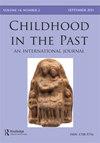The Archaeology of American Childhood and Adolescence
IF 0.5
Q3 ANTHROPOLOGY
引用次数: 6
Abstract
Children and childhoods have been a neglected topic within historical archaeology, often with a limited or only passing reference to children when a toy is uncovered at a site. However, since the 2000s, the study has started to gain favour in the field as archaeologist’s transition away from simply noting the presence of children into more in-depth discussions of children as social agents. Negotiating the archaeology of children and childhood in America is difficult given the spectrum of definitions, ideologies and social constructs; for example, how does the author define children or childhood? What are the temporal and spatial ranges of the study? And how is the intersectionality of identities such as class, ethnicity, gender, and race addressed by the author? On one hand, the threat is that the author can be overly ambitious and attempt to cover every subtopic, every time period, and every culture, thus presenting the audience with a disjointed bricolage of writing that only touches upon important issues without providing a thorough analysis. On the other hand, the author runs the risk of neglecting the diversity of the past and thus can create a work that homogenizes the study of children and childhood. The key for the scholar is to discuss the heterogeneity and intersectionality of the past while also narrowing the scope of the work into a concise narrative. For the most part, Jane Eva Baxter is able to accomplish this difficult task in her book, The Archaeology of American Childhood and Adolescence. This book is very much a sequel to Baxter’s 2005 book, The Archaeology of Childhood: Children, Gender, and Material Culture, in which she discussed similar topics but without the explicit purview of ‘American Childhood’. While restricting the range of childhood and adolescence to one nation helps to narrow the focus of the book, it also brings up a question: is there a monolithic identity of being American? Baxter attempts to answer this question by stating that,美国儿童与青少年考古
在历史考古学中,儿童和童年一直是一个被忽视的话题,当一个玩具在一个地方被发现时,儿童往往是有限的或只是短暂的提及。然而,自2000年代以来,随着考古学家从简单地注意到儿童的存在转变为更深入地讨论儿童作为社会代理人,这项研究开始在该领域获得青睐。考虑到定义、意识形态和社会结构的范围,在美国讨论儿童和童年的考古学是困难的;例如,作者如何定义儿童或童年?研究的时间和空间范围是什么?作者是如何处理阶级、民族、性别和种族等身份的交叉性的?一方面,威胁是作者可能过于雄心勃勃,试图涵盖每一个小主题,每一个时期,每一种文化,从而呈现给观众一个杂乱无章的写作,只触及重要问题,而没有提供彻底的分析。另一方面,作者冒着忽视过去的多样性的风险,因此可以创作一部同质化儿童和童年研究的作品。学者的关键是讨论过去的异质性和交叉性,同时也将工作的范围缩小到一个简洁的叙述。在很大程度上,简·伊娃·巴克斯特在她的书《美国童年和青春期的考古学》中完成了这一艰巨的任务。这本书在很大程度上是巴克斯特2005年著作《童年考古学:儿童、性别和物质文化》的续集,在那本书中,她讨论了类似的话题,但没有明确的“美国童年”的范围。虽然将童年和青春期的范围限制在一个国家有助于缩小这本书的焦点,但它也提出了一个问题:作为美国人是否有一个单一的身份认同?巴克斯特试图回答这个问题,他说,
本文章由计算机程序翻译,如有差异,请以英文原文为准。
求助全文
约1分钟内获得全文
求助全文
来源期刊

Childhood in the Past
Social Sciences-Anthropology
CiteScore
0.90
自引率
0.00%
发文量
16
期刊介绍:
Childhood in the Past provides a peer-reviewed, interdisciplinary, international forum for the publication of research into all aspects of children and childhood in the past, which transcends conventional intellectual, disciplinary, geographical and chronological boundaries. The editor welcomes offers of papers from any field of study which can further knowledge and understanding of the nature and experience of childhood in the past.
 求助内容:
求助内容: 应助结果提醒方式:
应助结果提醒方式:


